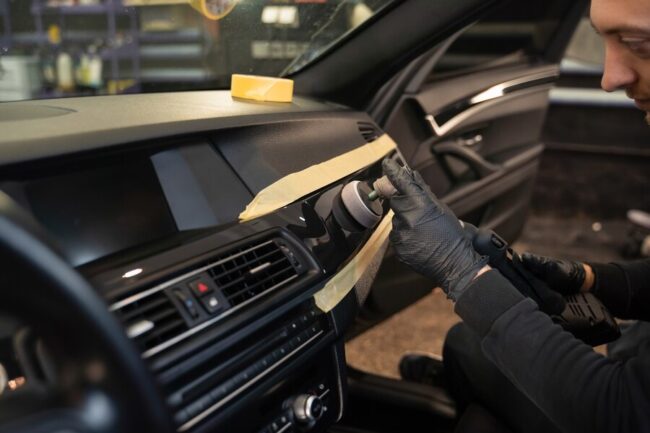Imagine stepping into your car on a scorching summer day. As you settle into the driver’s seat, you’re greeted by a blast of heat that makes you wince. Or picture working in an office with large windows, where the sun’s rays create unbearable hot spots that disrupt your concentration. These scenarios are all too familiar, highlighting the challenges of maintaining comfortable interior environments in vehicles and buildings, especially in hot climates.
Thankfully, there’s a solution that goes beyond traditional window tinting: IR (Infrared) rejection films. These innovative films are designed to block harmful UV rays and glare and tackle heat at their source by rejecting infrared radiation. This blog will explore the science behind IR rejection in window tinting and how it is crucial in maximizing interior comfort. Whether you’re a car owner looking to beat the heat during your daily commute or a business owner aiming to create a more pleasant working environment, understanding the benefits of IR rejection is critical to enhancing your comfort and well-being.
Understanding Infrared Radiation
Understanding infrared radiation is crucial for comprehending the impact of IR rejection in tinting on interior comfort. Infrared radiation, a form of electromagnetic radiation, is invisible to the human eye but is felt as heat. It comprises near, mid, and far infrared wavelengths, with sunlight being a significant source. Near-infrared radiation contributes to solar heat gain, while mid and far-infrared radiation is emitted by objects as heat. In the context of window tinting, IR rejection films are designed to block these wavelengths, thereby reducing the amount of heat transmitted into vehicles or buildings.
This reduction in infrared radiation helps maintain cooler interior temperatures, enhancing comfort and reducing reliance on air conditioning. Understanding these principles is fundamental for choosing the right window tinting solution to achieve optimal interior comfort.
IR Rejection In Window Tinting
Window tinting is an effective solution for reducing infrared (IR) radiation inside vehicles and buildings. IR radiation, part of the sunlight spectrum, is responsible for a significant portion of heat buildup in enclosed spaces. IR rejection films used in window tinting are designed to selectively block or reflect IR radiation while allowing visible light to pass through. This technology helps maintain comfortable interior temperatures by reducing the heat entering through windows.
- Technology: IR rejection films are engineered using advanced materials and coatings targeting specific IR radiation wavelengths. They can block different ranges of IR radiation, including near, mid, and far infrared, which contribute to heat buildup.
- Effectiveness: The effectiveness of IR rejection films is measured by their IR rejection rate, which indicates the percentage of IR radiation blocked or reflected by the film. Higher IR rejection rates result in greater heat reduction and improved interior comfort.
- Benefits: Besides heat reduction, IR rejection films offer other benefits such as UV protection, glare reduction, and protection against fading of interior furnishings and upholstery. By reducing the amount of IR radiation entering a space, these films also contribute to energy savings by lowering the need for cooling systems.
- Types of Films: There are different types of IR rejection films available, including dyed, metallized, and ceramic films. Each type has its characteristics regarding IR rejection rate, visible light transmission, and durability. The choice of film depends on factors such as the desired level of IR rejection, aesthetic preferences, and budget.
- Professional Installation: Proper installation of IR rejection films is crucial for maximizing their effectiveness. Professional installers ensure that the film is applied evenly without any creases or air bubbles, which can affect its performance. They also have the expertise to recommend the correct type of film based on the specific needs of the vehicle or building.
Impact On Interior Comfort
IR rejection is crucial in enhancing interior comfort by effectively managing heat transfer through windows. Here are the key ways IR rejection contributes to a more comfortable interior environment:
- Temperature Regulation: IR rejection films help maintain a more consistent and comfortable temperature inside vehicles and buildings by reducing the heat that enters through windows. This means occupants can enjoy a more extraordinary interior even in hot climates, reducing reliance on air conditioning systems and improving energy efficiency.
- Even Temperature Distribution: By minimizing the impact of direct sunlight and infrared radiation, IR rejection films help prevent hot spots and uneven temperature distribution inside vehicles and buildings. This creates a more balanced and comfortable environment for occupants throughout the space.
- Glare Reduction: Besides heat, IR rejection films reduce glare caused by sunlight, which can be exceptionally bothersome in vehicles and workspaces. These films improve visibility and reduce eye strain by filtering out excessive light, contributing to a more comfortable and safer environment.
- UV Protection: Many IR rejection films also offer significant UV protection, blocking harmful ultraviolet rays that can cause skin damage and fade interior furnishings. This added benefit enhances comfort and helps preserve the interior aesthetics and longevity of vehicles and buildings.
Overall, the impact of IR rejection on interior comfort is significant, providing occupants with a more enjoyable, safer, and energy-efficient environment.
Choosing The Right IR Rejection Film
When selecting an IR rejection film for your vehicle or building, it’s essential to consider several factors to ensure you get the best performance and value. Here are some key points to keep in mind:
- IR Rejection Rate: This is the percentage of infrared radiation that the film blocks. Higher IR rejection rates indicate better heat rejection capabilities. Look for films with high IR rejection rates for maximum comfort.
- Visible Light Transmission (VLT): VLT refers to the amount of visible light that passes through the film. Balancing IR rejection with VLT is crucial to maintaining a comfortable natural light inside your vehicle or building. Choose a film with a VLT that meets your visibility and privacy needs.
- Film Construction: IR rejection films come in various constructions, including dyed, metallized, and ceramic. Each type offers different levels of performance and aesthetics:
- Dyed Films: These films use dye to absorb heat and reduce glare. They are cost-effective but may fade over time and have lower heat rejection capabilities.
- Metallized Films: These films have a thin metal layer reflecting heat and UV rays. They provide excellent heat rejection but can interfere with electronic signals and have a mirrored appearance.
- Ceramic Films: These films block heat and UV rays using ceramic particles. They offer superior heat rejection, durability, and clarity without interfering with electronic signals.
- Durability and Warranty: Consider the durability of the film and the warranty offered by the manufacturer. Look for scratch- and fade-resistant films with a warranty against bubbling, peeling, or discolouration.
- Professiodiscolourationion: Proper installation is crucial for maximizing the effectiveness of IR rejection films. Choose a reputable installer with experience installing window tinting to ensure a professional and long-lasting application.
Considering these factors, you can choose the proper IR rejection film that meets your interior comfort, heat reduction, and aesthetics needs.
Real-World Applications
- Vehicle Comfort: Imagine driving in a car equipped with high-quality IR rejection window tinting on a hot summer day. The tinting helps reduce the heat entering the vehicle, making the interior more comfortable for the driver and passengers. This allows for a more enjoyable and less sweaty commute, especially in regions with intense sunlight and high temperatures.
- Residential Comfort: In residential settings, homes with windows treated with IR rejection films experience improved comfort levels. These films help reduce solar heat gain, keeping indoor spaces more relaxed and comfortable, especially in rooms exposed to direct sunlight. This can lead to energy savings by reducing the need for air conditioning, making the home more comfortable and lowering utility bills.
- Commercial Buildings: Offices and commercial buildings also benefit from IR rejection window tinting. Employees working in spaces with tinted windows experience more consistent temperatures and less discomfort from heat buildup, particularly in areas with large windows or glass facades. This can lead to improved productivity and a more comfortable working environment.
- Retail Spaces: Retailers can create a more inviting shopping experience using IR rejection window tinting. Maintaining cooler temperatures inside the store makes customers more likely to stay longer and enjoy their shopping experience without feeling overheated. This can lead to increased sales and customer satisfaction.
- Healthcare Facilities: IR rejection window tinting can contribute to patient comfort in healthcare settings. Rooms with tinted windows can maintain more stable temperatures, essential for patients’ recovery and comfort, especially in areas where precise temperature control is essential, such as operating rooms or recovery areas.
Future Trends And Innovations
- Advanced Nanotechnology: Continued advancements in nanotechnology are expected to lead to even more efficient IR rejection films. Nanoparticles can selectively block infrared radiation while maintaining high visible light transmission levels, offering enhanced comfort without compromising visibility.
- Smart Tinting Solutions: Integrating intelligent technologies into window tinting films, such as electrochromic or photochromic materials. These films can adjust their tint levels dynamically in response to environmental conditions or user preferences, optimizing IR rejection based on real-time needs.
- Multifunctional Films: Development of window tinting films that offer not only IR rejection but also additional functionalities, such as self-healing properties, anti-fogging capabilities, or energy harvesting features. These multifunctional films aim to provide comprehensive solutions for enhancing comfort and sustainability.
- Improved Spectral Selectivity: Research into materials with enhanced spectral selectivity, allowing window tinting films to selectively block specific wavelengths of infrared radiation while maintaining high transmission of desirable wavelengths. This can lead to more efficient energy management and greater comfort customization.
- Integration with Building Automation Systems: Integration of IR rejection window tinting with intelligent building automation systems. This integration can enable automated control of tint levels based on occupancy, sunlight intensity, or time of day, maximizing comfort and energy efficiency.
- Environmentally Friendly Materials: Increased focus on developing IR rejection films using sustainable and eco-friendly materials. This includes bio-based polymers, recyclable coatings, and manufacturing processes with reduced environmental impact, aligning with the growing demand for sustainable solutions.
Conclusion
IR rejection in window tinting is crucial for maximizing interior comfort in vehicles and buildings. By effectively blocking infrared rays, tinted windows can significantly reduce heat buildup, maintain a cooler interior temperature, and reduce reliance on air conditioning systems. This enhances comfort for occupants and contributes to energy efficiency and environmental sustainability.
With advancements in IR rejection technology, such as ceramic films, consumers can now access solutions that offer superior heat rejection without compromising visibility or aesthetics. Whether it’s for a car, home, or office, investing in high-quality window tinting with IR rejection capabilities can lead to a more comfortable and enjoyable environment year-round




